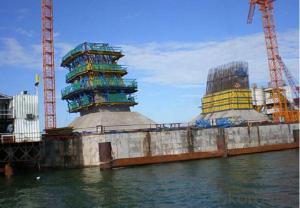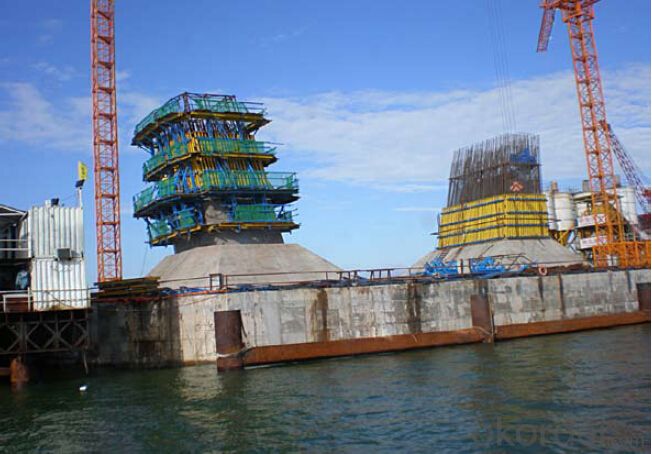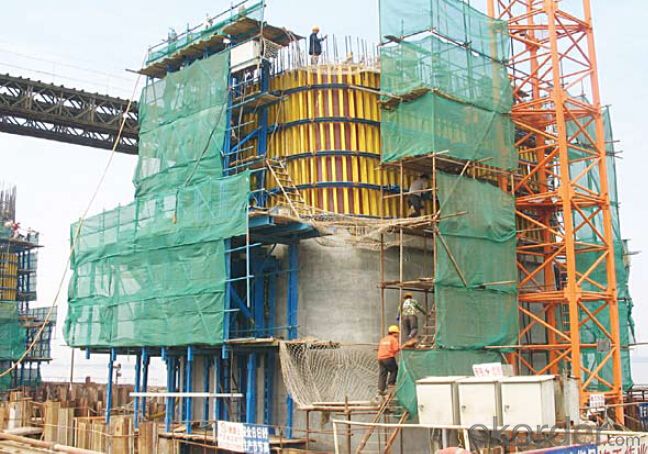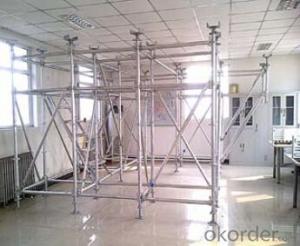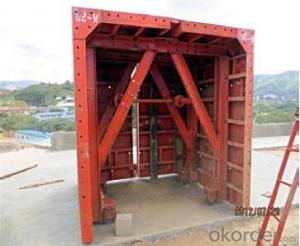Auto-Climbing bracket ACB-100 for formwork and scaffolding system
- Loading Port:
- Tianjin
- Payment Terms:
- TT OR LC
- Min Order Qty:
- 50 m²
- Supply Capability:
- 1000 m²/month
OKorder Service Pledge
OKorder Financial Service
You Might Also Like
Auto-climbing Bracket ACB100 & ACB50
The power of the auto-climbing formwork is the hydraulic system, which includes the oil cylinder
and two commutators. The commutators can control the climbing of climbing rail and the bracket.
The steel rail and the bracket can inter-climbing, so the whole system will climb up steadily.
Cranes are not needed during the construction. It’s easy to operate, highly efficient and safe. It’s
the best choice for the construction of high buildings and bridges.
There are mainly two types of standard auto-climbing brackets, ACB-50 and ACB-100, the figure
means the push power of cylinder with unit of KN.
Characteristics:
◆ Perfect load bearing anchor system
Anchor system is the most important supporting part. The system is made of five parts shown
below. Thereinto, tensile bolt, V-climbing cone and washer can be taken out for reusing after the
concrete pouring finished.There are two kinds of anchor systems,A & B. A is matched with single
anchor shoe and B is matched with double anchor shoe.
◆ Crane-independent
Crane-independent forming, striking and climbing speeds up the work procedures on the
construction site and also makes them independent of each other. This means the planned
sequences can be maintained along with guaranteeing high productivity levels. The crane can
therefore be used for other tasks.
Hydraulic system is mainly made of two commutators,
oil cylinder and power distribution system.The
commutators can control the climbing of climbing rail
and bracket.
◆ High bearing capacity and safe
The stable working platforms are able to carry large loads, e.g. the storage of reinforcing steel
for the next climbing section. Generously-sized working platforms, the well thought-out design for
handling very high wind loads and the patented control function of the climbing mechanism are
some of the special details contained within the comprehensive safety concept.
◆ Platforms adjusted to suit the angle of inclination
The horizontal working areas thus created provide safe and comfortable conditions for
reinforcement work, shuttering and striking, concreting and finishing.
◆ The ACB formwork system can climb not only vertically but also slantways, the largest angle is
18 degrees.
◆ The system can climb up wholly or separately. The climbing process is steady, synchronous
and safe.
◆ The bracket will not fall to the ground until the construction is finished, the field will be saved
and the impacting breakage will be reduced (especially the panel).
◆ The system will furnish omnidirectional platform, the construction organizations don’t need to
set up additional operation platform.
◆ The error of structure construction is small and easy to correct.
◆ The climbing speed is fast, the construction course will be quickened.
◆ The formwork can climb itself and cleaning work can be done in the same situs , the used times
of tower crane will be greatly reduced.
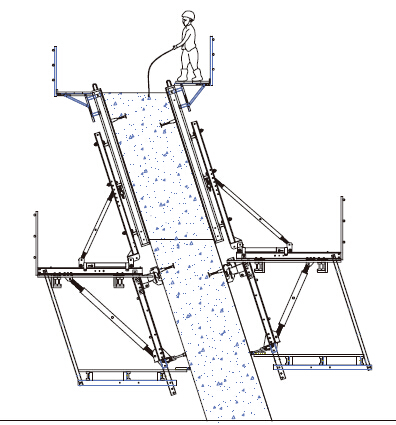
- Q: Can steel formwork be used for tunnel construction projects?
- Steel formwork is indeed suitable for tunnel construction projects. Its durability allows it to withstand the pressure and forces exerted during tunnel construction. Moreover, it provides a robust and stable structure for pouring concrete and forming the tunnel walls. An added advantage is that steel formwork is reusable, making it a cost-effective option for tunnel construction projects. Furthermore, steel formwork can be easily tailored to meet the precise requirements of the tunnel design, enhancing efficiency and precision during construction. In conclusion, steel formwork's strength, durability, and flexibility make it an excellent choice for tunnel construction projects.
- Q: What are the different types of scaffolding used with steel formwork?
- Steel formwork can be used with various types of scaffolding, each having its own unique features and advantages. 1. Tube and Coupler Scaffolding is widely utilized with steel formwork. It comprises vertical tubes connected by couplers, enabling easy adjustment and flexibility in terms of height and width. It is renowned for its strength and stability, making it suitable for heavy-duty construction projects. 2. H-frame Scaffolding, similar to the tube and coupler system, employs H-shaped frames instead of vertical tubes. It is lightweight and easily assembled and disassembled, making it ideal for small-scale construction projects or areas with limited space. 3. Cuplock Scaffolding is a modular system that utilizes pre-fabricated components, including vertical standards with cup joints and horizontal ledgers. Its quick assembly and disassembly make it a popular choice for time-sensitive projects. Additionally, it is known for its versatility, as it can be used for both straight and curved structures. 4. Ringlock Scaffolding, like cuplock scaffolding, uses a rosette joint system instead of cups. This allows for greater flexibility in assembling and adjusting the scaffolding. With its durability and high load-bearing capacity, ringlock scaffolding is suitable for heavy construction projects. 5. Kwikstage Scaffolding is another modular system that employs pre-fabricated components, including standards, ledgers, and transoms. It offers excellent flexibility in terms of height and width adjustments and can be quickly assembled and dismantled. Kwikstage scaffolding is commonly used in construction projects requiring frequent movement and repositioning of scaffolding. In conclusion, the choice of scaffolding for steel formwork depends on specific project requirements, such as load-bearing capacity, flexibility, ease of assembly, and durability.
- Q: What is the maximum load that steel formwork can bear?
- The maximum load that steel formwork can bear depends on various factors such as the type and thickness of the steel used, the design and construction of the formwork, and the support system in place. Steel formwork is known for its strength and durability, making it capable of supporting heavy loads. However, it is important to consult the manufacturer's specifications and guidelines to determine the exact maximum load capacity of a particular steel formwork system. These specifications are typically based on extensive testing and engineering calculations, ensuring the safety and structural integrity of the formwork. Additionally, it is crucial to consider other factors such as the load distribution, formwork layout, and the overall stability of the structure. Professional engineers and contractors should be involved in the design and installation process to ensure that the maximum load capacity is not exceeded and that the formwork is safely supported throughout the construction process.
- Q: How does steel formwork contribute to the overall energy efficiency of the building?
- Steel formwork contributes to the overall energy efficiency of a building in several ways. Firstly, steel has excellent thermal conductivity, allowing it to absorb and dissipate heat effectively, which helps in maintaining a comfortable indoor temperature and reducing the reliance on heating and cooling systems. Additionally, steel formwork provides a strong and durable structure that minimizes air leakage and heat loss, improving the overall insulation of the building. Moreover, steel formwork is reusable and can be easily dismantled and repurposed, reducing the energy and resources required for manufacturing new formwork for future construction projects. Overall, steel formwork plays a crucial role in enhancing the energy efficiency of buildings, leading to reduced energy consumption and lower carbon emissions.
- Q: Can steel formwork be used for tall structures?
- Yes, steel formwork can be used for tall structures. Steel is a strong and durable material that can withstand the weight and pressure of concrete. It offers the necessary stability and support required for constructing tall buildings and structures. Additionally, steel formwork is versatile, allowing for flexibility in design and construction.
- Q: How does steel formwork affect the overall labor productivity in construction?
- Steel formwork can significantly improve labor productivity in construction. Compared to traditional wooden formwork, steel formwork offers higher durability, increased reusability, and enhanced accuracy. Its modular design allows for faster assembly and disassembly, reducing construction time and labor requirements. Additionally, steel formwork provides a smooth finish to concrete structures, minimizing the need for additional finishing work. Overall, the use of steel formwork in construction can streamline the construction process, optimize labor productivity, and contribute to cost savings.
- Q: Can steel formwork be used for tunnel linings?
- Yes, steel formwork can be used for tunnel linings. Steel formwork is a versatile and durable solution that can be customized to fit the specific requirements of tunnel construction. It provides a strong and rigid structure, capable of withstanding the pressures and forces exerted by the surrounding ground and any potential water ingress. Steel formwork also offers the advantage of being reusable, making it a cost-effective option for tunnel linings. Additionally, steel formwork can be easily assembled and disassembled, allowing for efficient and timely construction of tunnel linings.
- Q: Can steel formwork be used for both cast-in-place and precast concrete construction?
- Yes, steel formwork can be used for both cast-in-place and precast concrete construction. Steel formwork is versatile and can be easily adjusted and modified to suit different construction methods. In cast-in-place construction, steel formwork is commonly used to create temporary molds or frameworks that hold the liquid concrete in place until it hardens and gains strength. Once the concrete is set, the formwork can be removed and reused for subsequent pours. In precast concrete construction, steel formwork is used to create permanent molds or frameworks that shape the concrete elements off-site. These precast elements are then transported to the construction site and installed as a part of the overall structure. Steel formwork is highly durable and can withstand the high pressures and forces involved in precast concrete construction. Overall, steel formwork offers numerous advantages such as strength, durability, reusability, and adaptability, making it suitable for both cast-in-place and precast concrete construction methods.
- Q: Can steel formwork be used for complex geometric designs?
- Complex geometric designs can indeed be achieved using steel formwork. Steel, being a versatile material, can be effortlessly shaped and molded into diverse intricate forms, thereby making it well-suited for such designs. By employing steel formwork, construction can be carried out with utmost precision and accuracy, guaranteeing the attainment of the desired shape and dimensions. Moreover, the robustness and longevity of steel render it capable of withstanding the weight and pressure exerted during the pouring of concrete, thus establishing steel formwork as a dependable option for the creation of complex geometric designs in construction endeavors.
- Q: Can steel formwork be used for both flat and sloped concrete surfaces?
- Yes, steel formwork can be used for both flat and sloped concrete surfaces. Steel formwork is known for its versatility and durability, making it suitable for various types of concrete structures. It can be easily adjusted and shaped to create both flat and sloped surfaces, allowing for the construction of diverse architectural designs. Additionally, steel formwork provides excellent support and stability to the concrete during the pouring and curing process, ensuring a high-quality and uniform finish on both flat and sloped surfaces.
Send your message to us
Auto-Climbing bracket ACB-100 for formwork and scaffolding system
- Loading Port:
- Tianjin
- Payment Terms:
- TT OR LC
- Min Order Qty:
- 50 m²
- Supply Capability:
- 1000 m²/month
OKorder Service Pledge
OKorder Financial Service
Similar products
Hot products
Hot Searches
